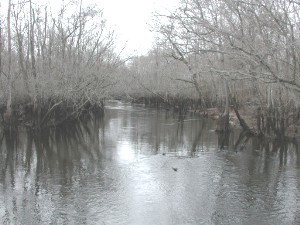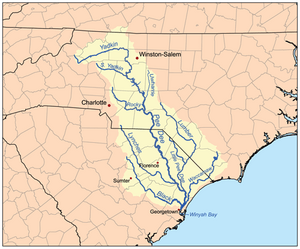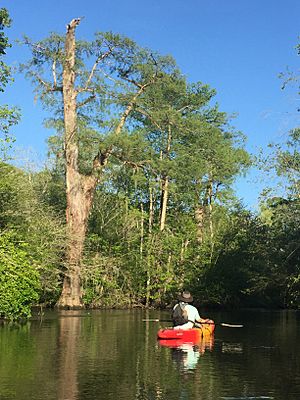Lynches River facts for kids
Quick facts for kids Lynches River |
|
|---|---|

Lynches River in winter, Johnsonville, South Carolina
|
|

Pee Dee River watershed.
|
|
| Country | United States |
| State | North Carolina, South Carolina |
| Physical characteristics | |
| Main source | Near Waxhaw, NC North Carolina 700 ft (210 m) |
| River mouth | Pee Dee River South Carolina |
| Length | 140 mi (230 km) |
The Lynches River is a beautiful waterway that flows through North Carolina and South Carolina in the United States. It gets its name from Thomas Lynch Jr., who was an important person who signed the Declaration of Independence.
The river starts near Waxhaw, North Carolina, high up at about 700 feet (210 meters) above sea level. It then travels a short distance to the South Carolina border. From there, it continues its journey until it joins the larger Great Pee Dee River near Johnsonville, South Carolina. The Lynches River is about 140 miles (225 kilometers) long. It drains an area of about 1030 square miles (2670 square kilometers).
Many parts of the Lynches River are special. The state of South Carolina has called them "wild and scenic." This means these sections are protected for their natural beauty. People love to go canoeing on the river. After Hurricane Hugo in 1989, many trees fell into the river. This made it hard to paddle in some spots. But people who love the river have been working to clear these blockages. The river is also a great place for fishing. You can catch sunfish, redbreast, catfish, and bass here.
Contents
Exploring the Lynches River's Journey
The Lynches River flows through different types of land. Each area has its own unique features. Let's explore the river's journey from its start to where it meets the Pee Dee River.
The River's Start: Upper Basin
The upper part of the Lynches River is in a region called the Piedmont. This area used to have tall mountains. Over a very long time, these mountains wore down. Now, the land has rocky clay soils. Much of the Piedmont is covered in forests. There are also some farms, especially around Pageland, South Carolina. Pageland is famous for its yearly watermelon festival!
This part of the river was important for gold and iron mining in the 1800s. People first found gold in the Lynches River around 1828. They used a method called placer mining. Before the Civil War, South Carolina had many gold mines. Most mining stopped in 1942. This happened because of a government rule during World War II.
Later, when gold prices went up, some old mines were looked at again. One mine, the Brewer gold mine, was reopened. It used modern machinery and technology to get gold. Between 1987 and 1991, this mine produced a lot of gold. However, in 1990, an accident happened. A chemical spill caused 11,000 fish to die in the Lynches River. The mine was closed for a short time for cleanup.
Middle Basin: Sandhills and Unique Bridges
As the river moves downstream, it leaves the Piedmont. It cuts through the sand hills region. This area used to be an old ocean shoreline. The hills here are thought to be old beach dunes. Today, these sand hills are used for growing peaches in orchards. There are also many pine plantations.
Near the river, you can find two special places. These are the Carolina Sandhills National Wildlife Refuge and the Sandhills State Forest. Both are in Chesterfield County, South Carolina.
At Bethune, South Carolina, there's a very interesting bridge. It's the only bridge in the world that crosses the same river three times without the river splitting! The Lynches River makes a big "S" shape where US Highway 1 crosses it.
Lower Basin: Wide Valleys and Farmland
After the sand hills, the river valley gets wider. The river starts to meander more. It flows through the coastal plain. As it passes Bishopville, South Carolina and Lynchburg, South Carolina, it goes through an area known for cotton farming. Bishopville is home to the South Carolina Cotton Museum.
Lee State Park is a great place to visit near the Lynches River. It's about 4 miles southeast of Bishopville. You can fish from the riverbanks there. Kids under 14 can fish in the Artesian Lake, which has catfish. There's also a boardwalk that takes visitors out into the Lynches River floodplain.
Further downstream, near Coward, South Carolina, you'll find Lynches River County Park. This park has nature trails and a cool elevated canopy walk. You can also go geocaching or canoeing. The park offers fun environmental education programs too.
As the floodplain gets wider, the riverbanks are covered with trees that love water. These include tupelo, bald cypress, and red maple. The higher lands from Effingham to Johnsonville, South Carolina are also rich farming areas. Tobacco is a main crop for farmers here. But they also grow corn, wheat, hay, and vegetables. Effingham has McCall Farms, which is South Carolina's only canning factory.
Near Johnsonville, the river passes what used to be the biggest factory along its path. This was Wellman Industries, which processed fiber and did recycling. Just below Johnsonville, the Lynches River flows into the Great Pee Dee River.
Ecology: Animals of the Lynches River
The Lynches River is home to many different animals. Some of these animals are very special and need protection.
The Carolina Heelsplitter
Part of the Lynches River is a very important home for an endangered animal called the Carolina heelsplitter. This is a type of freshwater mussel. The U.S. Fish and Wildlife Service has said this area is "critical habitat" for them. The Carolina heelsplitter is a medium-sized mussel. It can grow to almost 4.5 inches (110 millimeters) long. Its shell is usually greenish-brown to dark brown. These mussels are in danger because of pollution and too much dirt (silting) in the water. Only a few small groups of them are still known to exist.
The Ridged Lioplax
Another interesting water animal in the Lynches River is a type of gastropod (a kind of snail) called the Ridged Lioplax, or Lioplax subcarinata. South Carolina considers this a "Species of Concern." This means it's a species that needs to be watched carefully. It has only been found in the Lynches River and the Waccamaw River.


